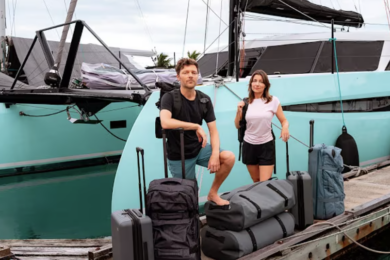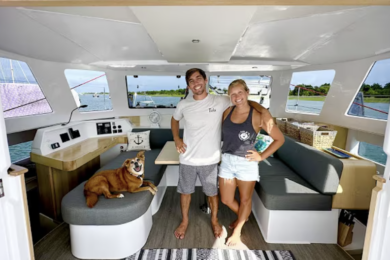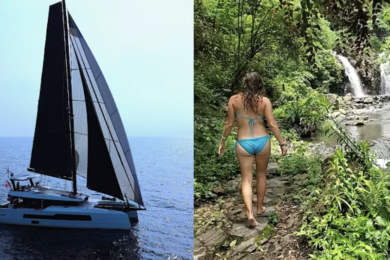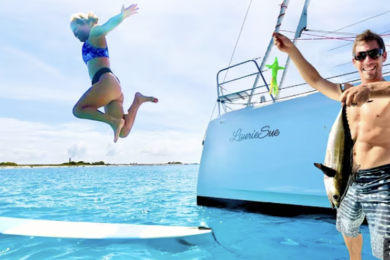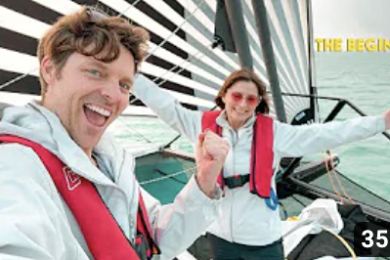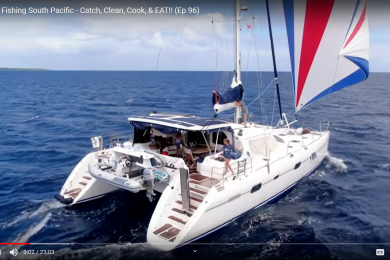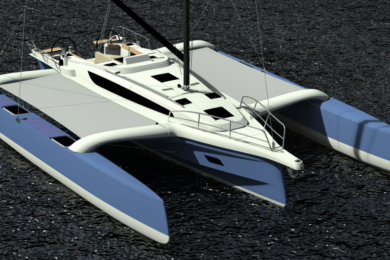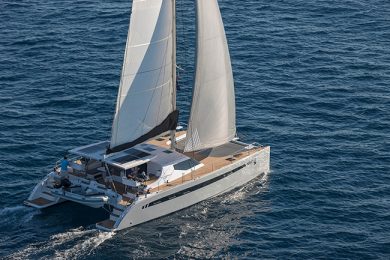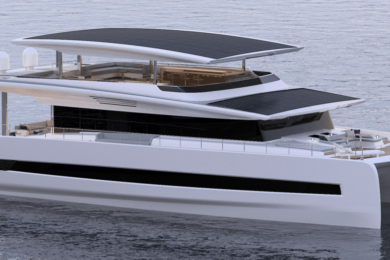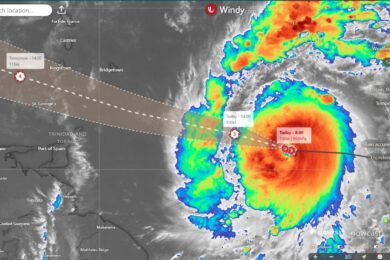The ins and outs (and ups and downs) of used cat values. (Published Winter 2013)

We all know that boats, unlike real estate, tend to depreciate. For those who are about to buy a catamaran, the question is: How much will it depreciate? Here at our brokerage firm, it is pretty common for someone to call and ask, “How much am I going to lose over the next two years if I buy this boat?”
Alas, no honest broker could answer this question with deep conviction because a wide range of factors—always shifting and unpredictable—impact the resale value of used catamarans. Nevertheless, my experiences as a catamaran broker have given me a pretty clear picture of the issues currently impacting used catamaran values.
CURRENCY FLUCTUATIONS
Since the majority of catamarans are built outside the U.S.—nearly 60 percent of them in France—the dollar/euro exchange rate plays a critical role in influencing new and used catamaran values. When you buy a French-built catamaran, you are to some extent making a euro play.
Certainly the cost of a new French cat dramatically impacts the value of used ones. For example, when the euro was very soft against the dollar three years ago, a Catana 431 could be bought new for under $500,000. Today, that same boat costs at least 30 percent more if purchased new. As such, if you bought a Catana 431 several years ago you would be able to sell her today for close to what you purchased her for. The demand for the 431 remains strong and supply low. The cost of a new 431 is simply out of reach for many buyers, so they must shift their attention to the brokerage market.
The same is so if you had bought a South African cat when the rand was weak against the dollar, as it was six years ago. A used Voyage 430 or 440 hardly depreciated over the past few years as the cost of getting a new one went up so much. That trend has since declined a bit in the global financial crisis, as it has for the Catana 431 and every other cat, but currency will always play a major factor in cat sales globally.
In short, if you think the dollar will get considerably stronger against the euro or the rand after you buy your new boat, you are taking a risk that depreciation will be higher than normal if you are an American buyer. If you are an Aussie, a European or a South African, the currency can work against you, or for you. Aussies are feeling strong now, buying a lot of cats, but the moment they stop mining in the West, their currency could crash—I doubt it, however! A recent visit to our Balance factory in China taught me that the world is going to consume raw materials until they are gone.
CONDITION
I was talking with one of our brokers about this article and he laughed: “If you want to avoid depreciation, take care of your boat.” And he is certainly right. The surest and fastest way to see the value of your boat go downhill is to treat her poorly. Survey after survey indicate that a general failure to follow the most simple rules of yacht maintenance end up costing sellers a lot of money. Changing engine oil and filters, taking care of the sail drive oil, changing out the zincs….many of these basic maintenance chores are overlooked, impacting resale in a significant manner.
Because condition plays such a powerful role in yacht depreciation, and because most buyers recognize that a well cared for yacht is like a well cared for airplane, there is a powerful antipathy in the boat buying community towards purchasing anything that spent much time in bareboat charter. It is assumed that an ex-charter boat is going to be pretty beat up. As such, if a boat goes into charter, even if it isn’t poorly cared for, its resale value will instantly be negatively impacted.
I happen to believe that this general impression of charter boats is misguided. Boats are managed by a wide range of charter companies, and some of them do a much better job maintaining their fleets than others. Also, some boats get a lot more use in charter than others. There are plenty of well maintained ex-charter boats on the market, often representing a pretty good value when buying a used catamaran. In the end, however, the true condition of a boat (chartered or non-chartered) cannot be ascertained until an objective surveyor has performed a rigid survey.
CONFIGURATION
The layout of the cat you buy will strongly impact her resale value. At the present time, the supply demand curve looks like this:
- Highest Demand
Owner version catamarans that have never seen bareboat charter. True owner version boats, configured for personal rather than charter use, did not become popular until the end of the 90s. Right now an owner version cat will fetch considerably more money on the used market than any other configuration. Owner versions are the most popular on cats 48 feet and under. Over that, many buyers buy larger cats because they want and need more beds or wish to charter their boats.
- Second Highest Demand
Owner version catamarans that have seen light charter. The demand for an owner version in the under 48-foot market often trumps the desire to avoid an ex-charter cat. In other words, if the price is right, most buyers these days will do anything to have that owner version—even if it was in charter.
- Third Highest Demand
Four-cabin, two-head catamarans that have never seen charter. Many cats in the late 90s came in this configuration and it is far more desirable on the aftermarket to have two central heads, which are much larger than four small heads.
- Fourth Highest Demand
Four-cabin, two-head catamarans that have seen some charter. For the most part, as noted above, when a buyer hears charter he fears abuse.
- Fifth Highest Demand
Because so many catamarans are sent into charter fleets, there are always a lot of heavily used four-cabin, four-head boats on the market. Sadly, these boats are in low demand, high supply and tend to drag down the value of similar models that were never in charter or configured in either two head or owner version layouts. The Internet shopper looking for that “bargain” cannot understand why an owner version of the same year as a charter version should fetch $40,000 to $80,000 more. As such, while he might really want a non-chartered boat or an owner version, he cannot justify spending the extra money to get one—or simply cannot afford it. That said, when he goes to sell the four-cabin, four-head boat, his resale value will remain low as he will always compete with the latest “phased out” offerings from the larger charter outfits. Since the global financial crisis, the supply of ex-charter cats has remained strong, while the limited supply for non-charter cats has dwindled as so few new cats were built from 2008 to 2011. Demand for new cats is only now beginning to come back.
BRAND
Brand is obviously a very important factor to consider when thinking about depreciation. When it comes to selling a used cat, the great value of a well-known brand is that buyers do not have to fly to the Caribbean or Europe to decide if they like a Lagoon 410, or a Moorings 4500, or a Catana 471. As most catamaran buyers attend at least a few major shows prior to making a purchase, it is likely they will be familiar with the brands that are shown regularly. For this reason, I tell clients who want us to sell a used catamaran that is not well branded, or custom built, to please bring her to our Florida or Annapolis locations where she can be easily seen and shown.
At the present time, the strongest charter/cruising cat brands in North America, in no particular order, are as follows: Lagoon, Moorings/Leopard (Robertson and Caine), Fountaine Pajot, Voyage and Gemini. Each of these brands has a dedicated sales force, advertising and consistent boat show presence. For many years, Privilege Catamarans had a strong North American presence, but they have not been showing catamarans here consistently for the past few years.
The strongest non-charter, performance cruising cat brands are Catana, Dolphin and Outremer. Buyers for these sorts of cats are equally concerned with how the boat sails as with how it lives at the dock or mooring. They tend to be more experienced yachtsmen who are converting from a monohull to a catamaran or upgrading from a previous catamaran. Few place their boats in charter and most intend to do serious blue water voyaging. While the market is smaller for such catamarans, the supply of used performance cruising cats is always a lot lower. True performance cats are never “phased out” of charter fleets in bulk. As such, resale value for used owner version Catanas, Outremers and Dolphins is generally very strong. In the Global Financial Crisis, the used performance cats held up better than any other brands in the brokerage market as the less serious buyers stopped buying, while the very serious voyagers did not. Part of the reason (full disclosure) that we invested in our own new brand, Balance Catamarans, was to serve this undeserved part of the market. It requires limited scale production of high quality in labor markets outside of Europe and North America that allow you to spend nearly triple the labor hours required to build a factory production boat.
There is really only one production built super high-performance catamaran brand at this time: The Gunboat from China and the USA. This dimension of the market can be likened to the Ferrari in the car market; there is a very small pool of buyers who will not be satisfied with anything but super high performance under sail. Of course there are always a wide range of custom-built cats on the market for the high performance buyer, including designs by Chris White, Ian Farrier and a host of Australian designers. Resale value on such “unbranded” yachts—which are built by a range of different builders—generally varies enormously as the quality of the build varies a great deal.
SOUTH AFRICAN AND
AUSTRALIAN BRANDS
Other than Moorings/Robertson & Caine/Leopard, Voyage, St. Francis and Gunboat, the bulk of the South African builders have, to date, not invested heavily in branding. Many of the smallest builders in South Africa, some of whom have gone bankrupt, sought to sell their boats factory direct to avoid the costs associated with establishing a serious dealer network and costly print advertising. Unfortunately, this has led to somewhat inconsistent marketing, after-client care and fluctuating resale values on the used market.
This does not mean that there are not any good quality, modestly marketed and branded South African cats. St. Francis Marine, for example, has operated on a small scale for years.
Australian catamarans have never been able to make much of a dent in the North American market. Sea wind is by far the most successful brand and they have shown their boats consistently the past few years at North American boat shows.
NEW CONSTRUCTION COSTS
In addition to brand recognition, used boat prices are strongly influenced by new boat prices. Whenever new boat prices rise, used boat values are lifted. One thing that has strongly influenced new boat prices over the past two years, in addition to currency fluctuations, has been the rising cost of fiberglass, resin and foam, which are petroleum based. Raw material costs have gone up all the way around in the marine industry. As long as new construction costs keep soaring, used boats will depreciate less and a lot more slowly. And some will actually appreciate.
OPTIONS THAT ADD VALUE
Many sellers assume that the more options you have on a boat, the more you will fetch for her when you decide to sell. This is not always the case.
When buying a new boat, the less you option her, the less depreciation you will have over the first two years of ownership because the way the boat is configured will be to your taste, not someone else’s. A near new or two-year-old boat placed on the used market will always compete with the new boats. If the new boat price does not rise substantially two years after you buy, many buyers will get a new boat the way they want it unless your catamaran is selling for at least 10 percent less.
The problem with the fully optioned boat, I have learned, is that new boat buyers seldom run the numbers as carefully as they should on what a truly well equipped new catamaran actually costs. If they see a year 2006 model for sale that has $80,000 of options and it is selling for just a bit more than a 2008, they still tend to gravitate toward the new model.
In a standard cruising cat from Lagoon, Fountaine Pajot, Moorings, etc., the trend has been for the boats to become more and more like homes. Many catamaran buyers today are first time yacht owners looking at their cats as second homes. They are more concerned with comfort at anchor than comfort and speed underway.
As such, the options that add the most value to these buyers are:
Upgraded engines because these cats have keels and relatively full hulls, they do not perform as superbly upwind as a cat with daggerboards. As such, many of the owners simply prefer to motorsail upwind.
Upgraded refrigeration and freezer
Generator and air conditioning
Icemakers
In an owner version configuration, upgrades of electronics, radar and watermaker also add value to the boat when sold used.
You will get less value from:
Upgraded sails such as Spectra
Upgraded bowsprit and screecher
Solar panels and wind generator
Carbon mast and boom
Spectra rigging and halyards
Electric engines. The jury is out on this one; it is a lot safer from a resale standpoint to stick with diesels in my view.
In performance cruising cats you will get the most value from:
Efficient refrigeration
Top electronics and radar
Spinnakers and screechers
Solar panels and wind generators
Single side band radios or satellite radios
Watermakers
Upgraded anchors and storm gear
You will get a bit less value from:
Full carbon rigs
Upgraded sails such as Spectra
Upgraded engine size
Air conditioning and generator
IN CONCLUSION
All things being equal, I have found that a well branded cat typically will not sink in value much more than seven to 10 percent a year after the first two years of ownership. And maintenance costs will remain low for the first four to five years. Over the past three years most good catamarans have not depreciated at all in dollar terms due to the strength of the euro and rand, which have raised new boat prices and lifted brokerage prices.
I have also come to see that most well built cats never sink much below half their replacement value if they are maintained in good working order. In other words, a 1992 45-foot cat is seldom going to sell for much less than $200,000 unless she is really in need of a total refit. The problem, of course, is that while depreciation flatlines, maintenance spikes! I see far too many buyers make penny wise and pound foolish choices in this regard. They focus far too much on the entry price and never enough on the maintenance price and exit price.
At present the demand for catamarans is very high because people are now fully aware of the enormous advantages of a catamaran over a monohull for living aboard. Also, as gas prices climb, a number of buyers drawn to trawlers are looking to catamarans that motor and sail nicely at the typical speed of a trawler yet cost considerably less to buy and operate. While I cannot predict the future I believe the demand for well built and properly designed catamarans will continue to grow in the years ahead.
There is no sure-fire way for any broker to tell a buyer how much he will get for his cat when the time comes to sell. Sales were almost dead after September 11th here in the U.S. and another serious upset could do the same again.
In the end, I believe too many of us let money get in the way of our happiness. Often, I have buyers come to me saying they just do not have enough money to get the boat they want. My advice is always the same: “Just get a boat. If you cannot afford a cat, get a monohull. I can assure you the sunsets in St. Lucia look every bit as lovely from the deck of a 35-foot cat as they do from an 80-foot cat. Or, yes, a $30,000 1964 Pearson Alberg 35. The fish are the same too. And the azure water. And the bars and restaurants. You can do it on a 1994 Lagoon 37 for $150,000 and have a bang up good time. If you want to wait to get the dream boat, that is your choice. Just do it before you can’t.”
Phil Berman is the president of The Multihull Company and the author of several books on catamaran racing and sailing. He is a Certified Professional Yacht Broker from the Yacht Brokers Association of America and has attended hundreds of catamaran surveys around the world over the past 30 years.

